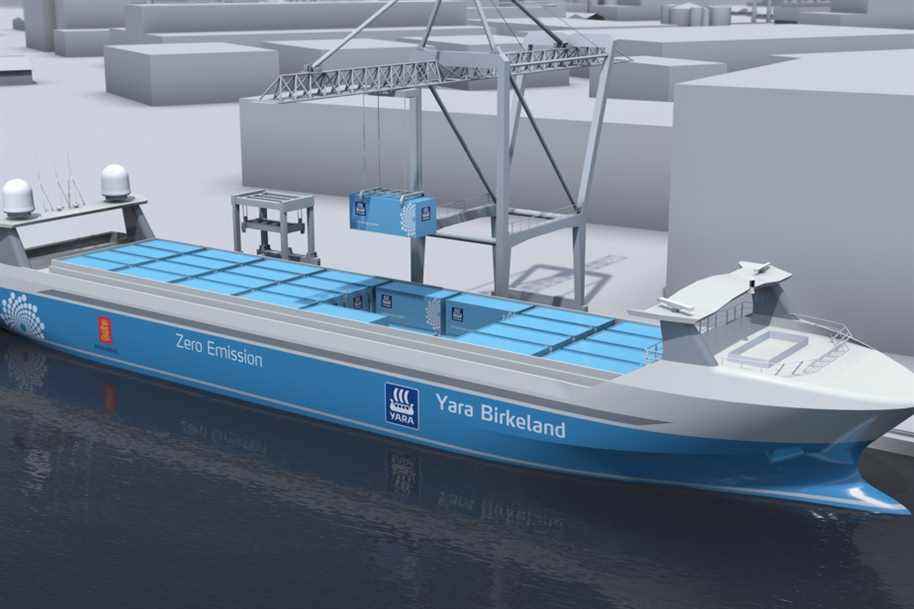(Oslo) Zero emissions and, soon, zero crew: the first 100% electric and autonomous cargo ship in the world was launched in Norway, a great technological breakthrough and a small ecological contribution for a maritime sector seeking to reduce its footprint.
By transporting up to 120 containers of fertilizer by sea from a factory in Porsgrunn to the port of Brevik, some ten kilometers away, the Yara Birkeland, presented to the press on Friday, will avoid nearly 40,000 polluting truck trips annually.
“Of course, there have been difficulties, setbacks, but it is all the more gratifying to be able to be here today and to see that we have arrived there”, confides to AFP the general manager of Yara. , Svein Tore Holsether, in front of the slender blue and white silhouette of the boat moored at a quay in Oslo.
With many months of delay, the Yara Birkeland, 80 meters long and 3200 tonnes deadweight, will begin a two-year test campaign which will gradually help it do without the crew.
The gangway is expected to disappear, perhaps in “three, four or five years” according to Mr. Holsether, leaving the ship to travel its 7.5 nautical mile course daily on its own with the assistance of sensors.
“Many incidents that occur on ships are due to human error, due to fatigue for example,” explains project manager Jostein Braaten from the short-lived command post.
“Autonomous operations can ensure safe travel,” he said.
If the distance traveled is short, there are many obstacles: the Yara Birkeland will have to navigate a narrow fjord, pass under two bridges playing against the currents, make your way through merchant ships, pleasure boats and other kayaks before docking in one of Norway’s most crowded ports.
The coming months will be devoted to learning.
“First we have to detect that there is something, we have to understand that it is a kayak, then we have to determine what to do,” emphasizes Jostein Braaten.
“Big boats today don’t care about kayaks, they can’t. They can give signals, but they can’t maneuver or reverse to avoid an incident, ”he says.
Autonomy also requires the establishment of regulations that do not yet exist.
“One hundred Tesla”
On board of Yara Birkeland, the traditional engine room has been replaced by eight compartments lined with batteries which give the vessel a capacity of 6.8 MWh.
“The equivalent of a hundred Tesla”, decrypts Jostein Braaten.
Responsible for nearly 3% of total emissions of human origin, the maritime sector aims to reduce its emissions by 40% by 2030 and 50% by 2050.
All activities combined (international, domestic, fishing), its emissions have increased, according to the latest figures available from the International Maritime Organization (IMO), from 962 million tonnes of greenhouse gases in 2012 to more than 1 billion tonnes in 2018.
With its 678 tonnes of CO2 saved per year, the Yara Birkeland will represent a tiny contribution to climate efforts, which in any case cannot be generalized according to experts.
“Electricity has a ‘niche’ use, especially for ferries, because these are fairly short and stable routes, possibly on cabotage and river transport, but it is not very suitable for long ocean crossings”, notes Camille. Egloff, marine transportation specialist at the Boston Consulting Group.
“You not only need autonomy over a long distance, but also to equip port terminals with suitable charging stations. There is therefore a challenge not only of technology, but also of charging infrastructure requiring coordination of many stakeholders, ”she said.
While dozens of electric ferries already crisscross the fjords of Norway, a large producer of hydrocarbons paradoxically at the forefront of transport electrification, transoceanic ships will have to rely on other technological solutions (LNG, e-methanol, hydrogen, ammonia, etc.) to become green.
